A Simplified Guide: Writing a Literary Analysis
VerifiedAdded on 2022/09/09
|6
|1589
|43
AI Summary
Contribute Materials
Your contribution can guide someone’s learning journey. Share your
documents today.
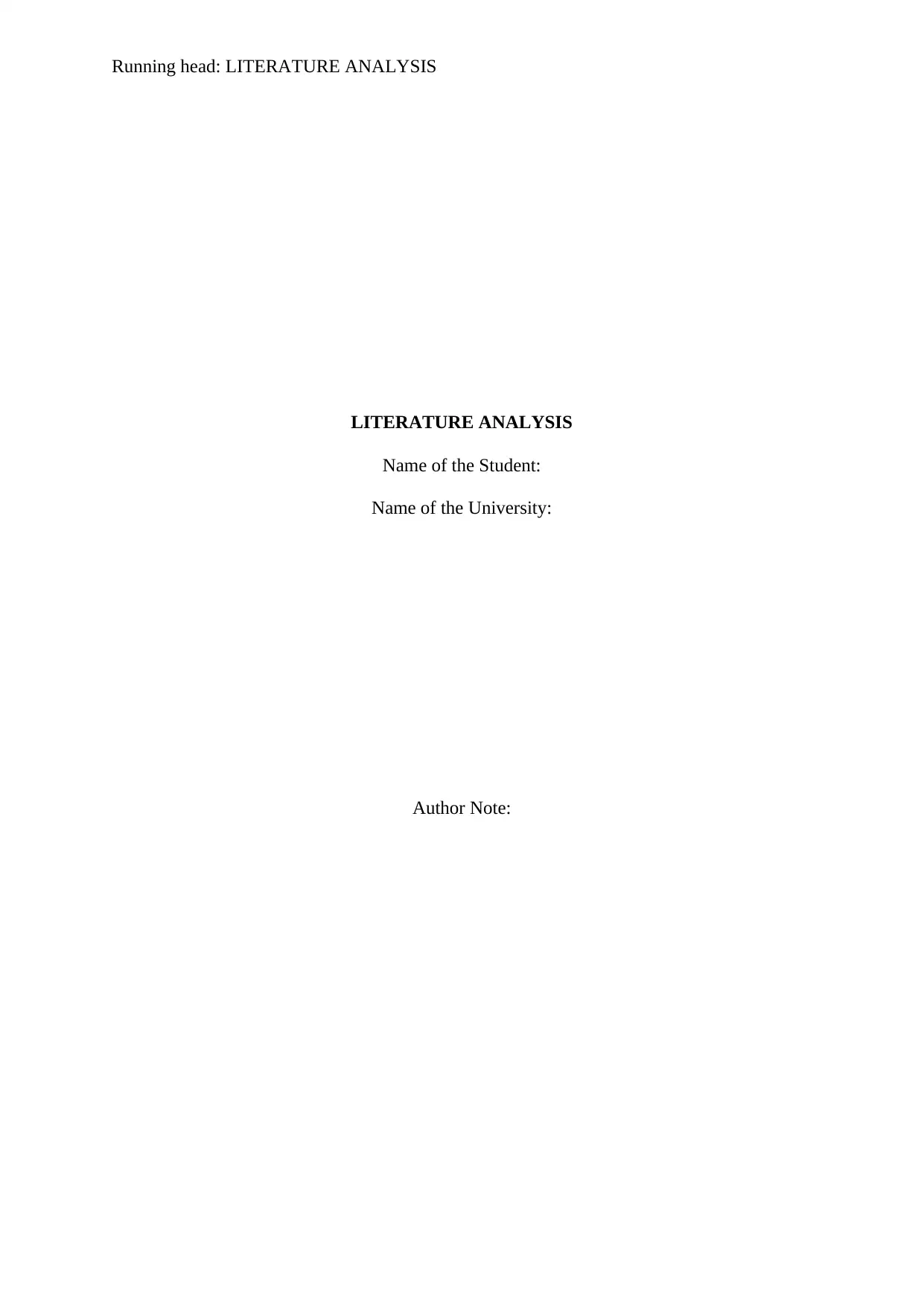
Running head: LITERATURE ANALYSIS
LITERATURE ANALYSIS
Name of the Student:
Name of the University:
Author Note:
LITERATURE ANALYSIS
Name of the Student:
Name of the University:
Author Note:
Secure Best Marks with AI Grader
Need help grading? Try our AI Grader for instant feedback on your assignments.
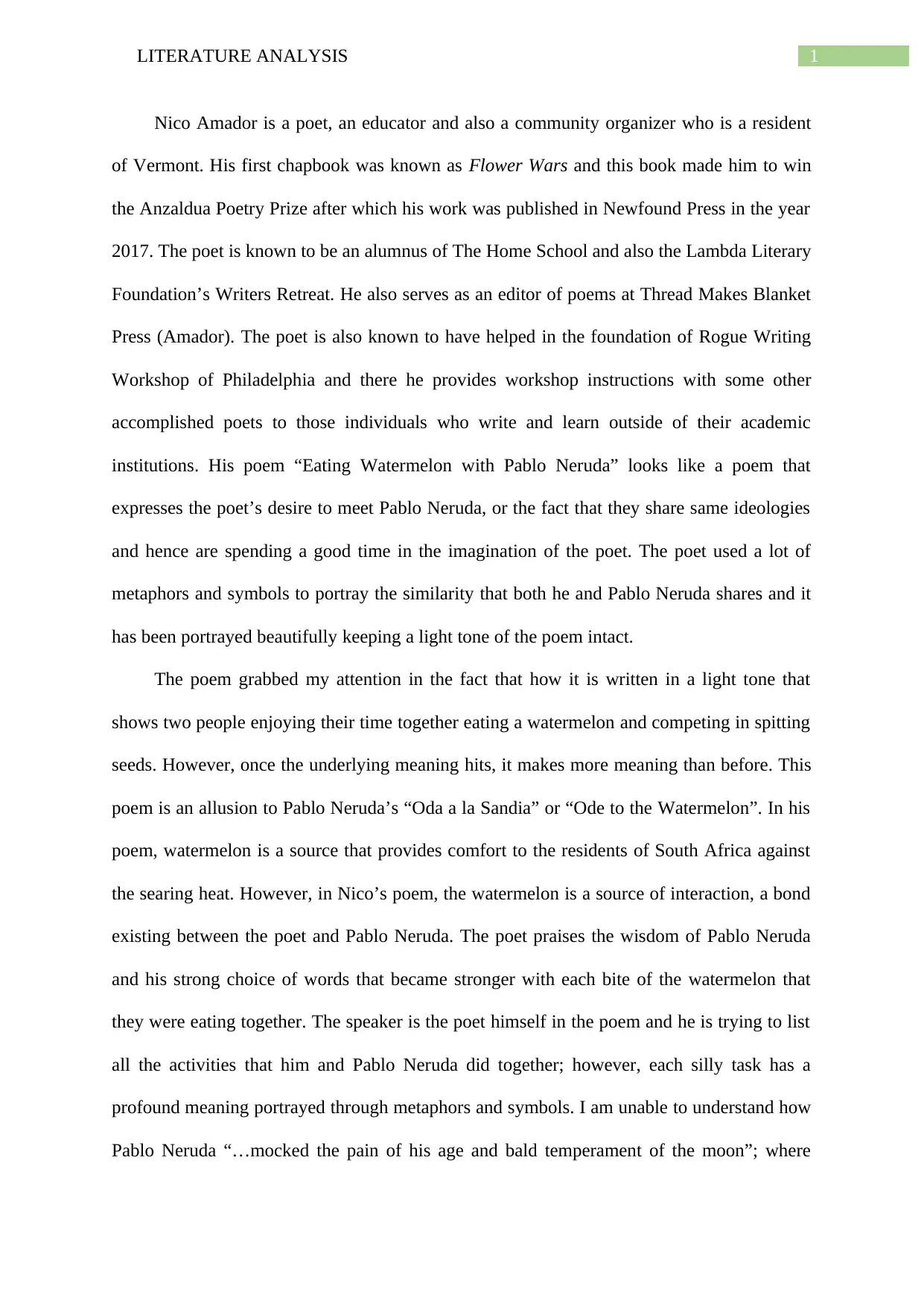
1LITERATURE ANALYSIS
Nico Amador is a poet, an educator and also a community organizer who is a resident
of Vermont. His first chapbook was known as Flower Wars and this book made him to win
the Anzaldua Poetry Prize after which his work was published in Newfound Press in the year
2017. The poet is known to be an alumnus of The Home School and also the Lambda Literary
Foundation’s Writers Retreat. He also serves as an editor of poems at Thread Makes Blanket
Press (Amador). The poet is also known to have helped in the foundation of Rogue Writing
Workshop of Philadelphia and there he provides workshop instructions with some other
accomplished poets to those individuals who write and learn outside of their academic
institutions. His poem “Eating Watermelon with Pablo Neruda” looks like a poem that
expresses the poet’s desire to meet Pablo Neruda, or the fact that they share same ideologies
and hence are spending a good time in the imagination of the poet. The poet used a lot of
metaphors and symbols to portray the similarity that both he and Pablo Neruda shares and it
has been portrayed beautifully keeping a light tone of the poem intact.
The poem grabbed my attention in the fact that how it is written in a light tone that
shows two people enjoying their time together eating a watermelon and competing in spitting
seeds. However, once the underlying meaning hits, it makes more meaning than before. This
poem is an allusion to Pablo Neruda’s “Oda a la Sandia” or “Ode to the Watermelon”. In his
poem, watermelon is a source that provides comfort to the residents of South Africa against
the searing heat. However, in Nico’s poem, the watermelon is a source of interaction, a bond
existing between the poet and Pablo Neruda. The poet praises the wisdom of Pablo Neruda
and his strong choice of words that became stronger with each bite of the watermelon that
they were eating together. The speaker is the poet himself in the poem and he is trying to list
all the activities that him and Pablo Neruda did together; however, each silly task has a
profound meaning portrayed through metaphors and symbols. I am unable to understand how
Pablo Neruda “…mocked the pain of his age and bald temperament of the moon”; where
Nico Amador is a poet, an educator and also a community organizer who is a resident
of Vermont. His first chapbook was known as Flower Wars and this book made him to win
the Anzaldua Poetry Prize after which his work was published in Newfound Press in the year
2017. The poet is known to be an alumnus of The Home School and also the Lambda Literary
Foundation’s Writers Retreat. He also serves as an editor of poems at Thread Makes Blanket
Press (Amador). The poet is also known to have helped in the foundation of Rogue Writing
Workshop of Philadelphia and there he provides workshop instructions with some other
accomplished poets to those individuals who write and learn outside of their academic
institutions. His poem “Eating Watermelon with Pablo Neruda” looks like a poem that
expresses the poet’s desire to meet Pablo Neruda, or the fact that they share same ideologies
and hence are spending a good time in the imagination of the poet. The poet used a lot of
metaphors and symbols to portray the similarity that both he and Pablo Neruda shares and it
has been portrayed beautifully keeping a light tone of the poem intact.
The poem grabbed my attention in the fact that how it is written in a light tone that
shows two people enjoying their time together eating a watermelon and competing in spitting
seeds. However, once the underlying meaning hits, it makes more meaning than before. This
poem is an allusion to Pablo Neruda’s “Oda a la Sandia” or “Ode to the Watermelon”. In his
poem, watermelon is a source that provides comfort to the residents of South Africa against
the searing heat. However, in Nico’s poem, the watermelon is a source of interaction, a bond
existing between the poet and Pablo Neruda. The poet praises the wisdom of Pablo Neruda
and his strong choice of words that became stronger with each bite of the watermelon that
they were eating together. The speaker is the poet himself in the poem and he is trying to list
all the activities that him and Pablo Neruda did together; however, each silly task has a
profound meaning portrayed through metaphors and symbols. I am unable to understand how
Pablo Neruda “…mocked the pain of his age and bald temperament of the moon”; where
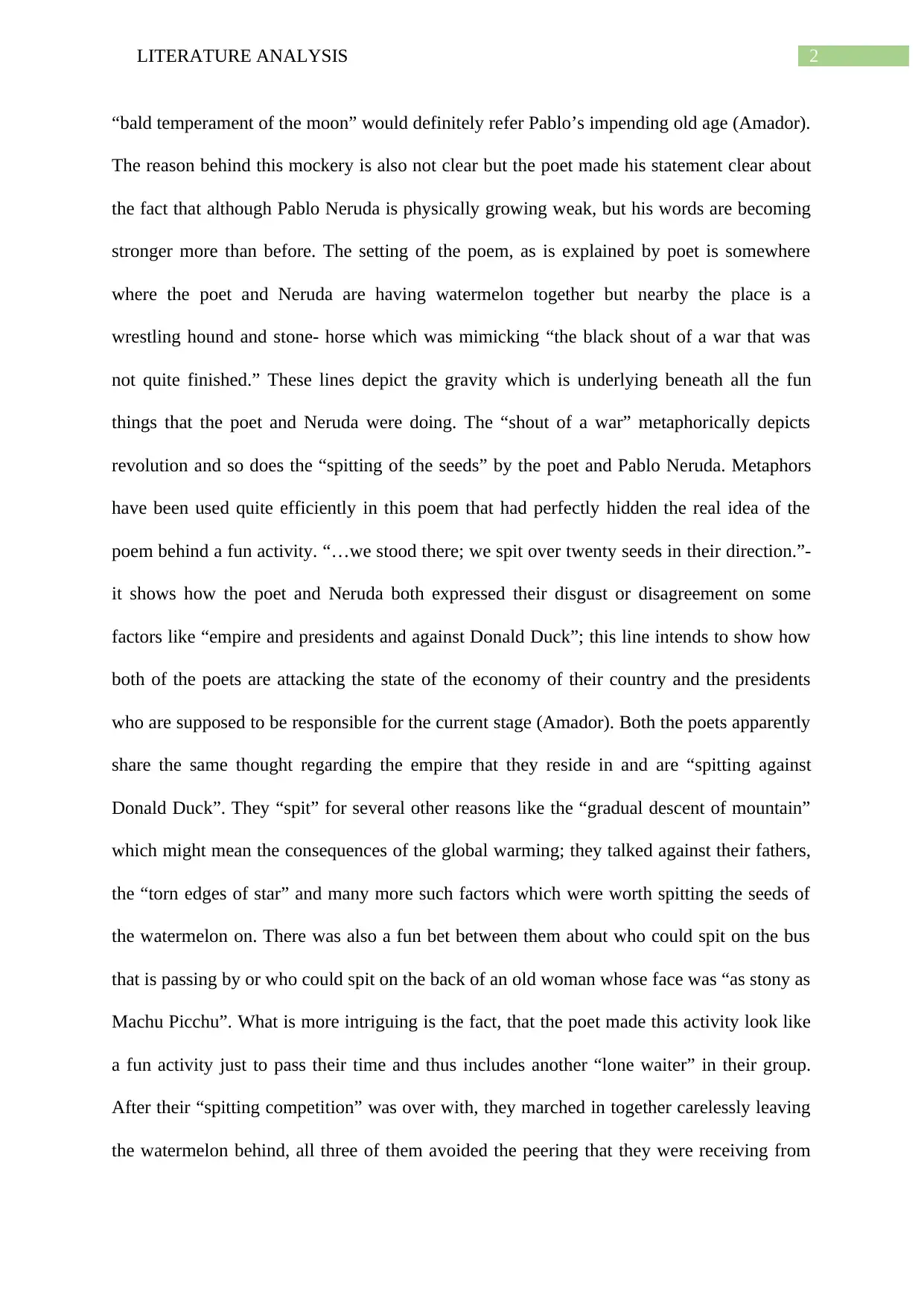
2LITERATURE ANALYSIS
“bald temperament of the moon” would definitely refer Pablo’s impending old age (Amador).
The reason behind this mockery is also not clear but the poet made his statement clear about
the fact that although Pablo Neruda is physically growing weak, but his words are becoming
stronger more than before. The setting of the poem, as is explained by poet is somewhere
where the poet and Neruda are having watermelon together but nearby the place is a
wrestling hound and stone- horse which was mimicking “the black shout of a war that was
not quite finished.” These lines depict the gravity which is underlying beneath all the fun
things that the poet and Neruda were doing. The “shout of a war” metaphorically depicts
revolution and so does the “spitting of the seeds” by the poet and Pablo Neruda. Metaphors
have been used quite efficiently in this poem that had perfectly hidden the real idea of the
poem behind a fun activity. “…we stood there; we spit over twenty seeds in their direction.”-
it shows how the poet and Neruda both expressed their disgust or disagreement on some
factors like “empire and presidents and against Donald Duck”; this line intends to show how
both of the poets are attacking the state of the economy of their country and the presidents
who are supposed to be responsible for the current stage (Amador). Both the poets apparently
share the same thought regarding the empire that they reside in and are “spitting against
Donald Duck”. They “spit” for several other reasons like the “gradual descent of mountain”
which might mean the consequences of the global warming; they talked against their fathers,
the “torn edges of star” and many more such factors which were worth spitting the seeds of
the watermelon on. There was also a fun bet between them about who could spit on the bus
that is passing by or who could spit on the back of an old woman whose face was “as stony as
Machu Picchu”. What is more intriguing is the fact, that the poet made this activity look like
a fun activity just to pass their time and thus includes another “lone waiter” in their group.
After their “spitting competition” was over with, they marched in together carelessly leaving
the watermelon behind, all three of them avoided the peering that they were receiving from
“bald temperament of the moon” would definitely refer Pablo’s impending old age (Amador).
The reason behind this mockery is also not clear but the poet made his statement clear about
the fact that although Pablo Neruda is physically growing weak, but his words are becoming
stronger more than before. The setting of the poem, as is explained by poet is somewhere
where the poet and Neruda are having watermelon together but nearby the place is a
wrestling hound and stone- horse which was mimicking “the black shout of a war that was
not quite finished.” These lines depict the gravity which is underlying beneath all the fun
things that the poet and Neruda were doing. The “shout of a war” metaphorically depicts
revolution and so does the “spitting of the seeds” by the poet and Pablo Neruda. Metaphors
have been used quite efficiently in this poem that had perfectly hidden the real idea of the
poem behind a fun activity. “…we stood there; we spit over twenty seeds in their direction.”-
it shows how the poet and Neruda both expressed their disgust or disagreement on some
factors like “empire and presidents and against Donald Duck”; this line intends to show how
both of the poets are attacking the state of the economy of their country and the presidents
who are supposed to be responsible for the current stage (Amador). Both the poets apparently
share the same thought regarding the empire that they reside in and are “spitting against
Donald Duck”. They “spit” for several other reasons like the “gradual descent of mountain”
which might mean the consequences of the global warming; they talked against their fathers,
the “torn edges of star” and many more such factors which were worth spitting the seeds of
the watermelon on. There was also a fun bet between them about who could spit on the bus
that is passing by or who could spit on the back of an old woman whose face was “as stony as
Machu Picchu”. What is more intriguing is the fact, that the poet made this activity look like
a fun activity just to pass their time and thus includes another “lone waiter” in their group.
After their “spitting competition” was over with, they marched in together carelessly leaving
the watermelon behind, all three of them avoided the peering that they were receiving from
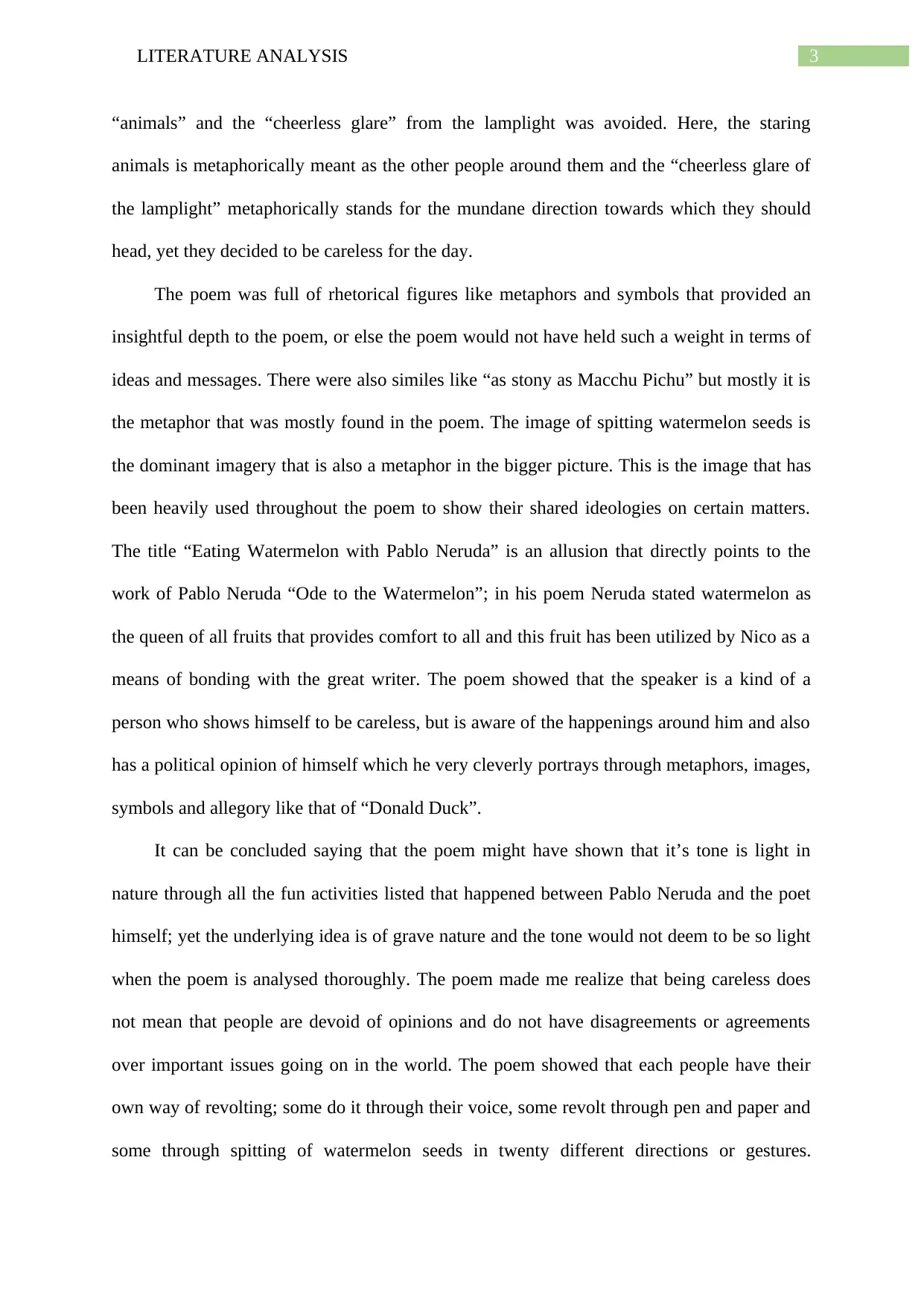
3LITERATURE ANALYSIS
“animals” and the “cheerless glare” from the lamplight was avoided. Here, the staring
animals is metaphorically meant as the other people around them and the “cheerless glare of
the lamplight” metaphorically stands for the mundane direction towards which they should
head, yet they decided to be careless for the day.
The poem was full of rhetorical figures like metaphors and symbols that provided an
insightful depth to the poem, or else the poem would not have held such a weight in terms of
ideas and messages. There were also similes like “as stony as Macchu Pichu” but mostly it is
the metaphor that was mostly found in the poem. The image of spitting watermelon seeds is
the dominant imagery that is also a metaphor in the bigger picture. This is the image that has
been heavily used throughout the poem to show their shared ideologies on certain matters.
The title “Eating Watermelon with Pablo Neruda” is an allusion that directly points to the
work of Pablo Neruda “Ode to the Watermelon”; in his poem Neruda stated watermelon as
the queen of all fruits that provides comfort to all and this fruit has been utilized by Nico as a
means of bonding with the great writer. The poem showed that the speaker is a kind of a
person who shows himself to be careless, but is aware of the happenings around him and also
has a political opinion of himself which he very cleverly portrays through metaphors, images,
symbols and allegory like that of “Donald Duck”.
It can be concluded saying that the poem might have shown that it’s tone is light in
nature through all the fun activities listed that happened between Pablo Neruda and the poet
himself; yet the underlying idea is of grave nature and the tone would not deem to be so light
when the poem is analysed thoroughly. The poem made me realize that being careless does
not mean that people are devoid of opinions and do not have disagreements or agreements
over important issues going on in the world. The poem showed that each people have their
own way of revolting; some do it through their voice, some revolt through pen and paper and
some through spitting of watermelon seeds in twenty different directions or gestures.
“animals” and the “cheerless glare” from the lamplight was avoided. Here, the staring
animals is metaphorically meant as the other people around them and the “cheerless glare of
the lamplight” metaphorically stands for the mundane direction towards which they should
head, yet they decided to be careless for the day.
The poem was full of rhetorical figures like metaphors and symbols that provided an
insightful depth to the poem, or else the poem would not have held such a weight in terms of
ideas and messages. There were also similes like “as stony as Macchu Pichu” but mostly it is
the metaphor that was mostly found in the poem. The image of spitting watermelon seeds is
the dominant imagery that is also a metaphor in the bigger picture. This is the image that has
been heavily used throughout the poem to show their shared ideologies on certain matters.
The title “Eating Watermelon with Pablo Neruda” is an allusion that directly points to the
work of Pablo Neruda “Ode to the Watermelon”; in his poem Neruda stated watermelon as
the queen of all fruits that provides comfort to all and this fruit has been utilized by Nico as a
means of bonding with the great writer. The poem showed that the speaker is a kind of a
person who shows himself to be careless, but is aware of the happenings around him and also
has a political opinion of himself which he very cleverly portrays through metaphors, images,
symbols and allegory like that of “Donald Duck”.
It can be concluded saying that the poem might have shown that it’s tone is light in
nature through all the fun activities listed that happened between Pablo Neruda and the poet
himself; yet the underlying idea is of grave nature and the tone would not deem to be so light
when the poem is analysed thoroughly. The poem made me realize that being careless does
not mean that people are devoid of opinions and do not have disagreements or agreements
over important issues going on in the world. The poem showed that each people have their
own way of revolting; some do it through their voice, some revolt through pen and paper and
some through spitting of watermelon seeds in twenty different directions or gestures.
Secure Best Marks with AI Grader
Need help grading? Try our AI Grader for instant feedback on your assignments.
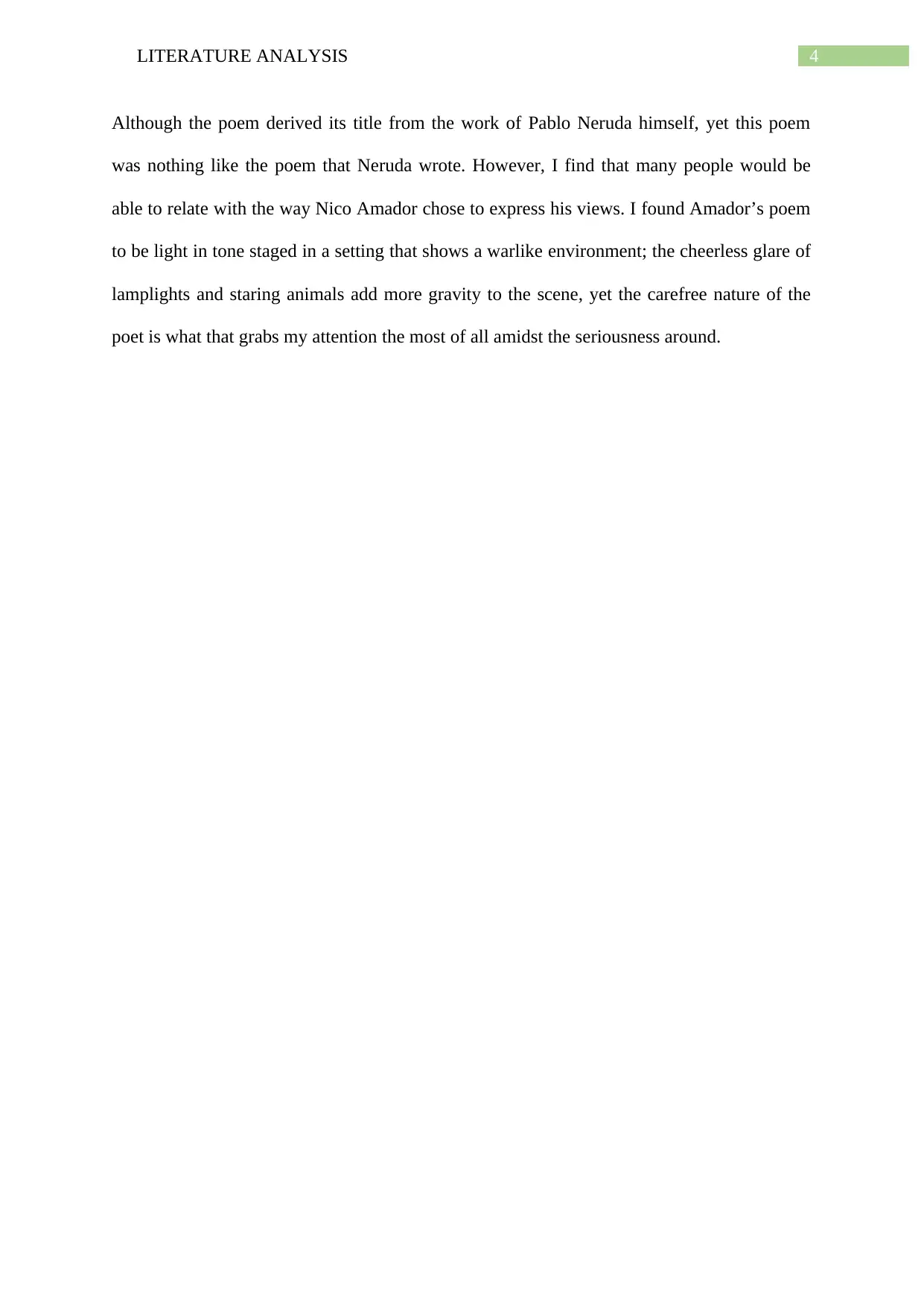
4LITERATURE ANALYSIS
Although the poem derived its title from the work of Pablo Neruda himself, yet this poem
was nothing like the poem that Neruda wrote. However, I find that many people would be
able to relate with the way Nico Amador chose to express his views. I found Amador’s poem
to be light in tone staged in a setting that shows a warlike environment; the cheerless glare of
lamplights and staring animals add more gravity to the scene, yet the carefree nature of the
poet is what that grabs my attention the most of all amidst the seriousness around.
Although the poem derived its title from the work of Pablo Neruda himself, yet this poem
was nothing like the poem that Neruda wrote. However, I find that many people would be
able to relate with the way Nico Amador chose to express his views. I found Amador’s poem
to be light in tone staged in a setting that shows a warlike environment; the cheerless glare of
lamplights and staring animals add more gravity to the scene, yet the carefree nature of the
poet is what that grabs my attention the most of all amidst the seriousness around.
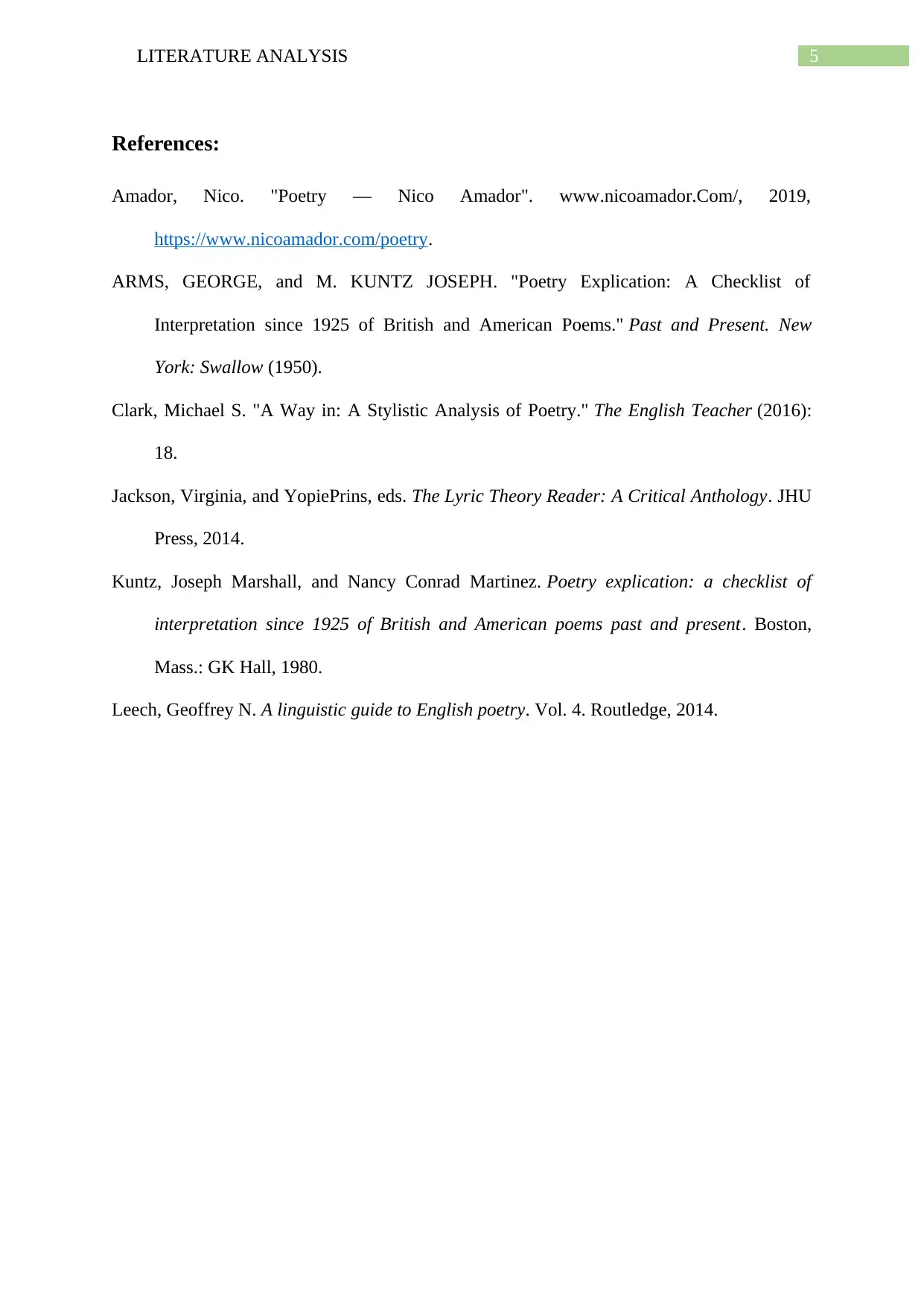
5LITERATURE ANALYSIS
References:
Amador, Nico. "Poetry — Nico Amador". www.nicoamador.Com/, 2019,
https://www.nicoamador.com/poetry.
ARMS, GEORGE, and M. KUNTZ JOSEPH. "Poetry Explication: A Checklist of
Interpretation since 1925 of British and American Poems." Past and Present. New
York: Swallow (1950).
Clark, Michael S. "A Way in: A Stylistic Analysis of Poetry." The English Teacher (2016):
18.
Jackson, Virginia, and YopiePrins, eds. The Lyric Theory Reader: A Critical Anthology. JHU
Press, 2014.
Kuntz, Joseph Marshall, and Nancy Conrad Martinez. Poetry explication: a checklist of
interpretation since 1925 of British and American poems past and present. Boston,
Mass.: GK Hall, 1980.
Leech, Geoffrey N. A linguistic guide to English poetry. Vol. 4. Routledge, 2014.
References:
Amador, Nico. "Poetry — Nico Amador". www.nicoamador.Com/, 2019,
https://www.nicoamador.com/poetry.
ARMS, GEORGE, and M. KUNTZ JOSEPH. "Poetry Explication: A Checklist of
Interpretation since 1925 of British and American Poems." Past and Present. New
York: Swallow (1950).
Clark, Michael S. "A Way in: A Stylistic Analysis of Poetry." The English Teacher (2016):
18.
Jackson, Virginia, and YopiePrins, eds. The Lyric Theory Reader: A Critical Anthology. JHU
Press, 2014.
Kuntz, Joseph Marshall, and Nancy Conrad Martinez. Poetry explication: a checklist of
interpretation since 1925 of British and American poems past and present. Boston,
Mass.: GK Hall, 1980.
Leech, Geoffrey N. A linguistic guide to English poetry. Vol. 4. Routledge, 2014.
1 out of 6
Your All-in-One AI-Powered Toolkit for Academic Success.
+13062052269
info@desklib.com
Available 24*7 on WhatsApp / Email
![[object Object]](/_next/static/media/star-bottom.7253800d.svg)
Unlock your academic potential
© 2024 | Zucol Services PVT LTD | All rights reserved.